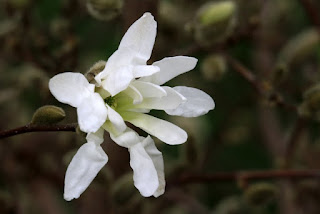Wednesday, January 2, was one of the nicest days we've had in a long while, sunny and pleasant after months of rainy and cold weather. My son-in-law and I decided to spend the day doing photography at the Northern State Hospital, a place I had heard of, but had never visited, except for one building. Our handicapped son was for six weeks at the North Sound Treatment Center, a modern facility on the grounds of the old hospital, but during the time we visited him there we only caught glimpses of the older buildings and grounds. This time we intended to explore them thoroughly and having seen pictures of the abandoned and derelict buildings on the internet, hoped to come home with some good photos, though we were unsure of what we would find, since there are other things now going on at the site.
Twin Sisters from Highway 9
(above also)
Northern State Hospital lies just off the North Cascades Highway (Highway 20) on the east side of the town of Sedro-Woolley. The Cultural Landscape Foundation describes it as follows: "Undertaken by the State of Washington in 1909, Northern State Hospital
was constructed as a state of the art, self-sustaining occupational
therapy and treatment facility for the mentally ill. Masterfully
designed by Olmsted Brothers, the site included patient and staff
housing, a dedicated reservoir, lumber mill, quarry, steam plant, and
more than 700 acres of farming and livestock operations. The hospital
ended operations in 1973 and, today, the Washington State Department of
General Administration and Skagit County are stewards of the site, and
has converted the agricultural area into the Northern State Recreation
Area."
Hospital and Administration Buildings
The hospital itself and the administration buildings are now off-limits, as we quickly found out. We had driven on the site to take pictures of some of the buildings and though were able to get a few photos were soon informed that we were not welcome. The agricultural area to the east of the hospital, however, is now a park and we spent a good part of the day walking the paths and photographing the derelict buildings, some of which are falling to pieces. The buildings include stables and barns and a cannery where the residents of the hospital once worked canning strawberries and vegetables: one of the signs said that as much as 1.5 million pounds of vegetables a year were canned, all of which were produced on the site. Some of the equipment from these efforts remains and is another attraction at the site.
Barns and Stables













































































































































